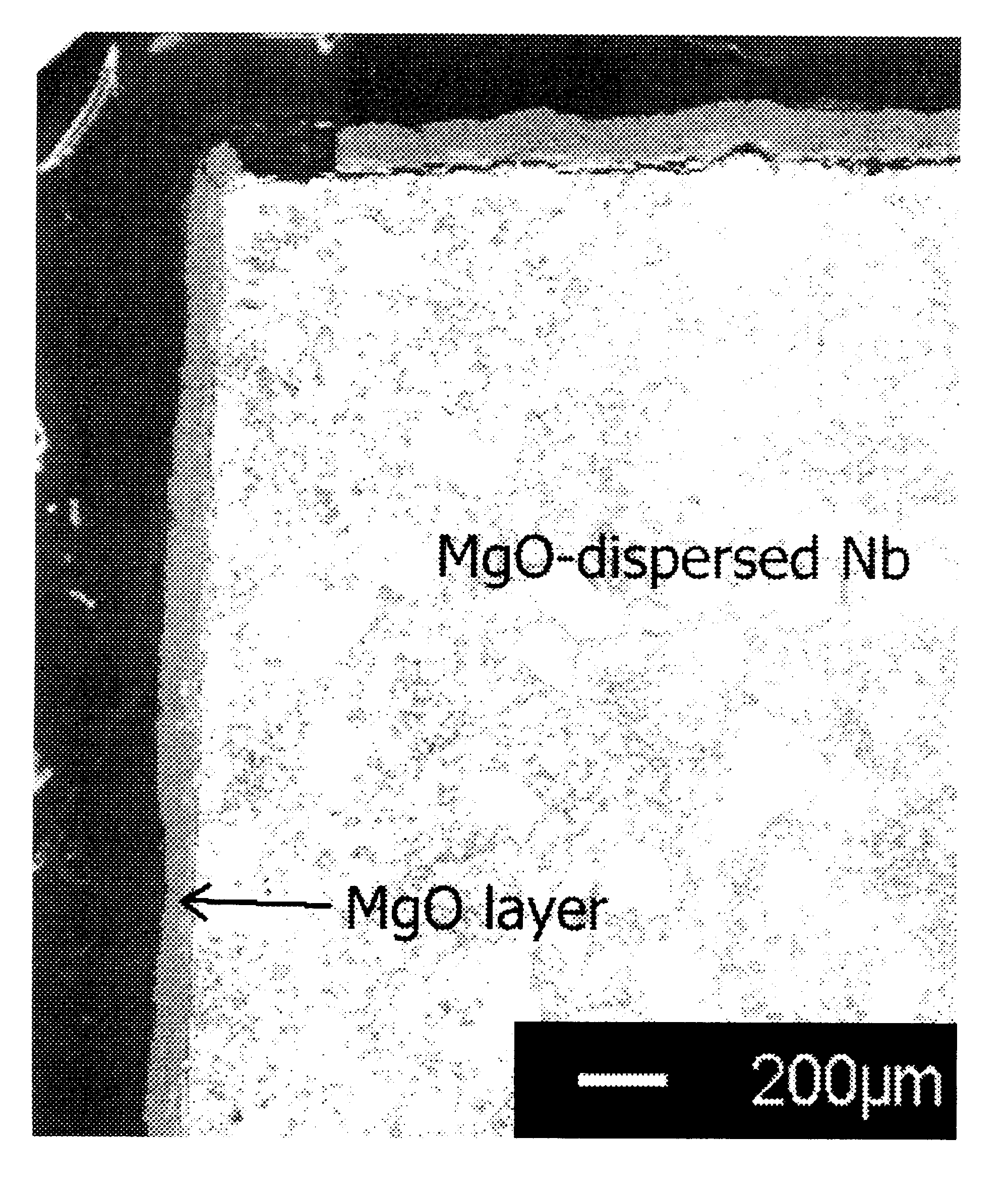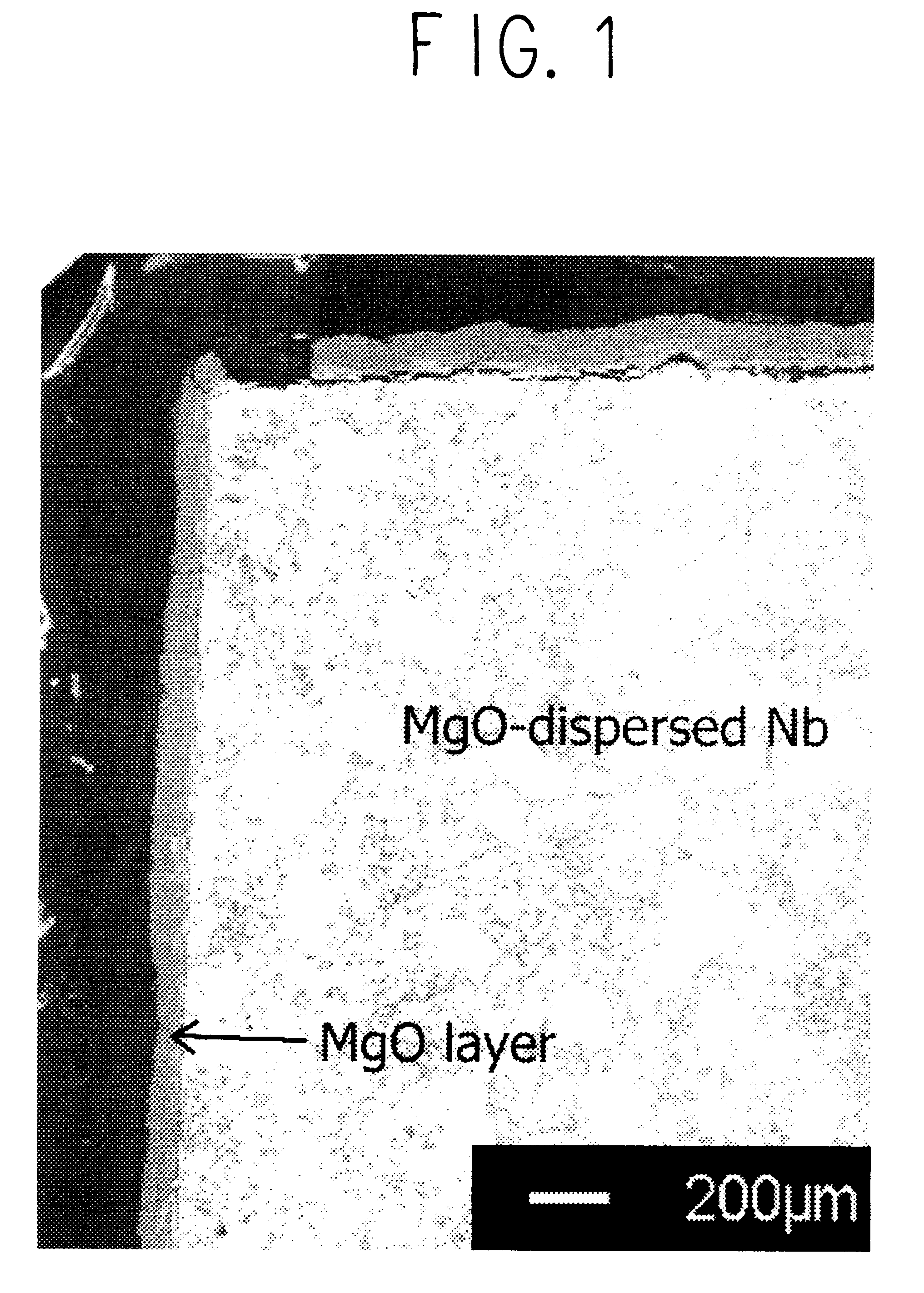High temperature oxidation resistant alloy materials and method of producing the same
a technology of oxidation resistance and alloy materials, which is applied in the direction of solid-state diffusion coating, machines/engines, mechanical equipment, etc., can solve the problems of low reliability, low reliability, and productivity, and achieve fatally inferior oxidation resistance of nb at an elevated temperatur
- Summary
- Abstract
- Description
- Claims
- Application Information
AI Technical Summary
Benefits of technology
Problems solved by technology
Method used
Image
Examples
example 1
Nb metal powder of up to #200 mesh, Ti metal powder of up to #200 mesh, Al raw material powder of up to #200 mesh and Mg.sub.2 Si powder of up to #40 mesh were blended to provide composition on an atomic percent basis of 38%Nb--38%Ti--18%Al--2%Si--4%Mg, and well mixed in a ball mill. Then the mixed powder was put in a graphite mold coated with BN, and hot-press sintered at 1700.degree. C. at uniaxial pressure of 30 MPa for 30 minutes in a vacuum atmosphere. After the sintering the sample was almost completely densified and a single phase of a solid solution metal phase was identified by X-ray diffraction and electron microscopic observation.
That composition corresponds to the composition in a phase diagram which becomes nearly a single phase of a metal phase at a temperature not less than 1200.degree. C. A rectangular sample was cut out from said sample and subjected to oxidation test in air at 1250.degree. C. for 60 hours using a thermo-balance. The weight increase by the oxidation...
example 2
Nb metal powder of up to #200 mesh, Ti metal powder of up to #200 mesh, and Al raw material powder of up to #200 mesh were blended to provide composition on an atomic percent basis of 40%Nb--40%Ti--20%Al, and MgO powder in an amount of 30% by weight (outer percentage) was added thereto and mixed well in a ball mill. As the MgO powder, fine powder of #325 was employed. Then the mixed powder was hot-press sintered under the same conditions as those used for Example 1 and a dense sintered product was obtained. The sintered product had a structure in which MgO phase was homogeneously dispersed in solid solution metal matrix. A rectangular sample was cut out from the sample and subjected to oxidation test in air at 1250.degree. C. for 60 hours using a thermo-balance. The weight increase by the oxidation was parabolic like Example 1, the sample after the oxidation test was covered with a dense oxide film comprising MgO as a main component. The alloy composition of the sample and the descr...
example 3
Nb metal powder of up to #325 mesh, Ti metal powder of up to #325 mesh, and Al raw material powder of up to #325 mesh were blended to provide composition on an atomic percent of 35%Nb--35%Ti--30%Al, and MgO powder in an amount of 15% by weight (outer percentage) was added thereto and well mixed in a ball mill. As the MgO powder, fine powder of #325 was employed. Then the mixed powder was hot-press sintered under the same conditions as those used in Example 1 and a dense sintered product was obtained. The sintered product had a structure comprising Nb--Ti--Al solid solution metal phase, (Nb, Ti)2Al intermetallic compound phase, and MgO phase as shown in phase diagram. A rectangular sample was cut out from the sample and subjected to oxidation test in air at 1250.degree. C. for 12 hours using a thermo-balance. The sample after the oxidation test was covered with a dense oxide film comprising MgO as a main component. The result is given in Example 3 of Table 1. As it can be expected, t...
PUM
| Property | Measurement | Unit |
|---|---|---|
| Percent by volume | aaaaa | aaaaa |
| Temperature | aaaaa | aaaaa |
| Oxidation resistance | aaaaa | aaaaa |
Abstract
Description
Claims
Application Information
 Login to View More
Login to View More - R&D
- Intellectual Property
- Life Sciences
- Materials
- Tech Scout
- Unparalleled Data Quality
- Higher Quality Content
- 60% Fewer Hallucinations
Browse by: Latest US Patents, China's latest patents, Technical Efficacy Thesaurus, Application Domain, Technology Topic, Popular Technical Reports.
© 2025 PatSnap. All rights reserved.Legal|Privacy policy|Modern Slavery Act Transparency Statement|Sitemap|About US| Contact US: help@patsnap.com


